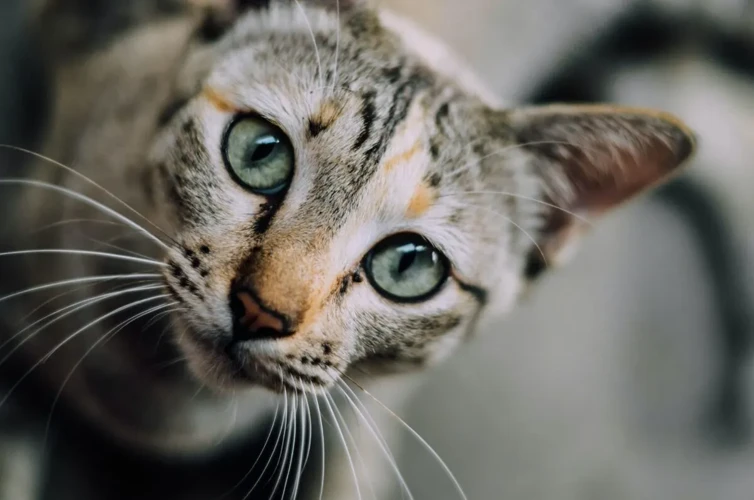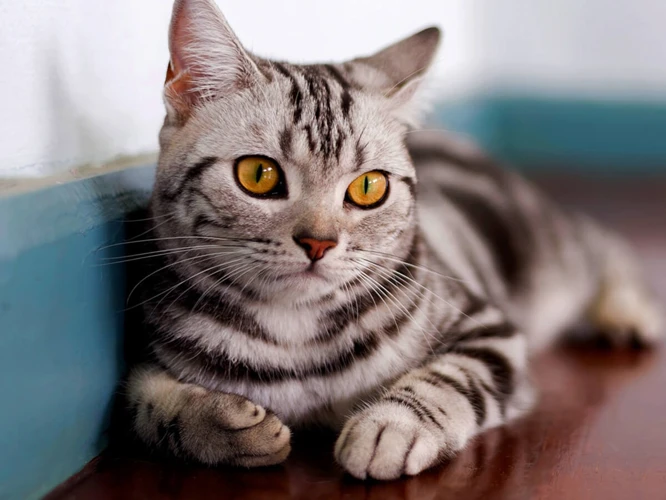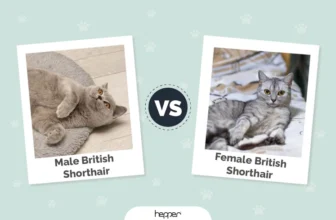It can be puzzling when your American Shorthair doesn’t seem to get along with other cats. Whether you’ve recently added a new feline to the household or your current cat is having trouble getting along with others, there are steps you can take to make the transition smoother. Understanding your cat’s personality and taking precautions before introducing them to others is crucial. Keep reading to discover expert tips on how to teach your American Shorthair to get along with other cats.
Understand your American Shorthair’s Personality

Understanding your American Shorthair’s personality is crucial when it comes to introducing them to other cats. Each cat has a unique personality, just like humans do. While some American Shorthairs may be more sociable and friendly towards other cats, others may be more reserved and territorial. Observing your cat’s behavior patterns and considering their age and gender can give you a better understanding of their personality. It’s essential to know your cat well to ensure a smooth introduction to other cats. If you are still getting used to your American Shorthair’s behavior, you may want to check out early socialization techniques used for American Shorthair kittens here.
1.1. Observe Behavioral Patterns
Observe Behavioral Patterns: American Shorthairs, like any breed of cat, have their own unique personality. Some cats may be more outgoing and confident, while others may be more timid and shy. It is important to observe your American Shorthair’s behavior around other cats before introducing them to a new feline friend.
Take note of how your American Shorthair reacts to other animals. Do they show signs of fear, aggression, or curiosity? If your cat is fearful or aggressive when interacting with other animals, it may take longer to teach them to get along with other cats. In this case, it may be advisable to consult with your veterinarian to rule out any underlying physical or behavioral issues that may be causing the aggression.
On the other hand, if your American Shorthair is curious and shows interest in other cats, it may be easier to teach them to get along with their new feline friend. However, it is important to remember that even cats that initially seem friendly may become territorial or aggressive when they feel threatened or stressed.
By observing your American Shorthair’s behavioral patterns, you can better understand their personality and how they may respond to a new cat in their home. This will help you develop a plan for introduction and minimize any conflict between the cats.
In addition to observing your cat’s behavior, it may also be helpful to seek the advice of a professional or experienced cat owner. They may be able to provide valuable insights and tips on how to help your American Shorthair adjust to a new cat and get along with them.
Internal Link to Relevant Article: If your American Shorthair is fearful of animals, check out our article on /help-am-shorthair-overcome-fear-animals/.
1.2. Consider Age and Gender
When introducing a new cat to your American Shorthair, it’s important to keep in mind each cat’s age and gender. Older cats can be less tolerant of younger cats, and males may have a tougher time getting along with other males due to territorial behavior. Females, on the other hand, tend to be more accepting of others.
To avoid any conflicts, it’s recommended to introduce cats of opposite sexes and different ages as they are more likely to get along. However, if you do decide to introduce cats of the same gender or similar age, make sure to do so carefully, ensuring that proper introductions are in place. By taking into consideration these factors, you can create a more harmonious environment for your American Shorthair and their new feline friend.
For further information on introducing an American Shorthair to a dog, check out our article on “How to Introduce an American Shorthair to a Dog”. If you are experiencing problems with your cats getting along, read our article on “Coping with Aggression and Conflict in American Shorthairs”. Additionally, find out how to create a safe space for American Shorthair playtime by reading our article on “Creating a Safe Space for American Shorthair Playtime”.
Pre-Introduction Preparations

Before introducing your American Shorthair to other cats, there are a few essential preparations that you should make to ensure the process goes smoothly. These pre-introduction preparations are crucial for cats who have never lived with other feline companions before, as it can be a significant adjustment for them. Taking these steps will help your cats become comfortable and confident in their surroundings, increasing the likelihood of them getting along well with each other. So, let’s dive into some crucial pre-introduction preparations that you should consider.
2.1.Take Your Cat for a Veterinarian Check-Up
Before introducing your American Shorthair to other cats, it is important to take them for a veterinarian check-up to ensure that they are healthy and up to date on their vaccinations. This is especially important if your cat has never been around other cats before.
During the check-up, the veterinarian may also be able to offer advice and guidance on how to introduce your American Shorthair to other cats based on their unique temperament and health.
Here’s an overview of what you can expect during the veterinarian check-up:
| Step | Description |
|---|---|
| 1 | The veterinarian will perform a physical examination to check your cat’s overall health. |
| 2 | The veterinarian may recommend blood work to screen for any underlying health issues. |
| 3 | The veterinarian will check your cat’s vaccination records and may recommend additional vaccinations if necessary. |
| 4 | The veterinarian will also check your cat for any parasites, which may include ticks, fleas, and worms. |
Once your American Shorthair has been cleared for introduction by the veterinarian, you can move on to the next steps in preparing for introducing them to other cats. Don’t skip this important step, as it can help ensure the health and safety of all cats involved.
2.2. Set Up Separate Living Quarters
When it comes to teaching your American Shorthair to get along with other cats, it’s essential to ensure that each cat has their own space. By setting up separate living quarters, you provide each cat with a retreat where they can relax and be alone. This separation is crucial in reducing territorial disputes that may arise when introducing a new cat into the household.
Here are some tips on how to set up separate living quarters for your cats:
- Provide individual sleeping areas: Each cat should have their own bed or designated sleeping area. This helps to avoid competition for sleeping spots and reduces any tension that may arise from sharing a bed.
- Set up separate litter boxes: Cats are particular about their bathroom habits, so it’s essential to provide each cat with their own litter box. It’s recommended to have one litter box per cat, plus an extra one. This helps to ensure that there are no conflicts over bathroom habits.
- Offer separate food and water dishes: Just like with litter boxes, each cat should have their own food and water dishes. This helps to avoid competition over resources and ensures that each cat gets the nutrients they need.
- Create separate play areas: Provide each cat with their own toys and play area, so they don’t have to compete for attention or resources. This promotes healthy play behavior and reduces the likelihood of territorial disputes.
By following these steps, you can create individual spaces for each cat and reduce the likelihood of conflicts during introductions. Remember, cats are creatures of habit, and it may take time for them to adjust to their new living quarters. Be patient and provide positive reinforcement to encourage good behavior.
Slow and Steady Introductions

The process of introducing your American Shorthair to other cats can be a bit overwhelming. However, taking things slow and steady can dramatically increase the success of a harmonious introduction. This stage of the process involves allowing your cats to become familiar with each other step-by-step, laying the foundation for a lasting bond. So, let’s dive into some effective techniques for making slow and steady introductions.
3.1. Introduce Scents First
When introducing your American Shorthair to other cats, the first step is to introduce scents before the actual physical meeting. This allows your cats to become familiar with each other’s scent, which is a crucial part of cat communication.
One way to introduce scents is by placing a piece of fabric or clothing with the new cat’s scent in a shared space, such as a common room or relaxation area. Alternatively, you can use a spray bottle to spritz the new cat’s scent around the shared space. Your American Shorthair will become accustomed to the new scent in their environment, which can help reduce anxiety and stress during face-to-face introductions.
However, it’s important to supervise your cat closely during this time to make sure they don’t become aggressive or territorial. Using a pet fence or gate to keep them separated while they become familiar with each other’s scents is recommended.
Remember to give your American Shorthair time to adjust to new scents and surroundings before moving onto physical introductions. Through a careful and slow introduction process, your American Shorthair will soon be on their way to enjoying the company of other cats.
| Do: | Avoid: |
|---|---|
| Introduce scents before physical meetings | Rushing the introduction process |
| Supervise your cat during this phase | Letting your cat become aggressive or territorial |
| Use a pet fence or gate to keep them separated | Letting your cat become overwhelmed |
3.2. Supervised Playtime
Supervised Playtime is a crucial step in acclimating your American Shorthair to other feline friends. This process should be done in a controlled environment where there is little to no escape route for the cats. It’s best to use a room in your home where your resident cat spends most of their time. You can then introduce the new cat for a 15-minute playtime session, under your watchful eye.
During the playtime session, there should be various toys available for the cats. You can use interactive toys such as stuffed toys that both cats can play with simultaneously. It’s also important to follow the cats’ cues during this time. If one cat is getting too aggressive, you may need to separate them promptly.
It’s important to make sure the new cat has a way to escape if things get out of control. For example, you can use a baby gate or some cardboard to create a barricade in the room where the cats are playing, allowing the cats to interact while still keeping them separate.
It’s also worth noting that not all cats are going to get along during the first playtime session. One cat may show aggression more often than the other, causing the other cat to shy away and hide. In such cases, it’s best to end the playtime session early and try again the next day.
Supervised Playtime is an essential step in the acclimation process. It allows the cats to interact and play, getting to know each other under your watchful eye. Remember, this is a slow process, and you should expect some hiccups along the way. But with patience and perseverance, your American Shorthair can learn to get along with other cats.
| Supervised Playtime Tips: |
|---|
| 1. Use a controlled environment with little to no escape route for the cats. |
| 2. Various toys should be available during the playtime session. |
| 3. Follow the cats’ cues during the playtime session, and separate if necessary. |
| 4. Create a barrier to allow the cats to interact while still keeping them separate. |
| 5. End the playtime session early and try again the next day if there is too much aggression. |
3.3. Gradual Increase of Interaction and Time Together
Now that your American Shorthair and the other cat(s) have become more familiar with each other’s scent and presence, it’s time to gradually increase their interaction and time spent together. Here are some steps to follow:
- Start with short and supervised play sessions: At first, only allow your cats to play together while you watch closely. This ensures that any possible conflicts are stopped before they escalate. Playtime is important because it helps your cats build positive associations with each other.
- Gradually increase the duration: As your cats become more comfortable with each other, you can start to increase the duration of their play sessions. However, it’s important to remain vigilant and supervise their interactions to ensure they remain positive.
- Allow them to share space: Once your cats have successfully interacted during their play sessions, you can start allowing them to share living space while supervised. Start by letting them be in the same room for short periods. Gradually increase the time as your cats become more relaxed and comfortable with each other.
- Consider feeding them together: Feeding is another activity that can help your cats bond. Start by feeding them on opposite sides of a closed door, and then move on to feeding them in the same room but with enough distance between them. Over time, you can move their food bowls closer together until they are comfortable eating side-by-side.
- Don’t force interactions: Remember, it’s important to let your cats take their time and let them move at their own pace. Don’t force them to interact if they don’t feel comfortable yet. Respect their boundaries and let them become comfortable with each other at their own pace.
By following these steps, you can help your American Shorthair and the other cat(s) develop a positive relationship. Remember, patience is key when it comes to introducing cats to each other.
Positive Reinforcement and Punishment

As you work to help your American Shorthair learn to get along with other cats, it’s important to understand the role that positive reinforcement and punishment can play in their training. By utilizing effective techniques for reinforcing good behavior and avoiding the use of negative punishment, you can help your furry friend learn how to interact with other cats in a positive and friendly way. In this section, we’ll explore the various methods you can use to encourage good behavior and address any issues that may arise.
4.1. Using Treats and Positive Reinforcement Techniques
When it comes to teaching your American Shorthair to get along with other cats, positive reinforcement is the way to go. Using treats and other positive reinforcement techniques can help reinforce good behavior and encourage your cat to continue behaving positively.
Treats: One of the most effective ways to incentivize your cat is through the use of treats. Treats can be used to reward your cat for good behavior or for responding positively to new cats or environments. Make sure to use a treat that your cat really enjoys to make the reward more enticing.
Clicker Training: Clicker training is another positive reinforcement technique that can be effective in training your American Shorthair to get along with other cats. Clicker training involves using a clicker to mark good behavior, followed by a treat. This creates a positive association with the clicker sound and helps build trust and positive behavior.
Verbal Praise: Verbal praise can be just as effective as treats or clicker training. Simply saying “good job” or “good kitty” when your cat behaves positively can reinforce good behavior. Make sure to use a cheerful and positive tone of voice when praising your cat.
Playtime: Playtime is another positive reinforcement technique that can help teach your American Shorthair to get along with other cats. Playtime can be used to teach your cat that interacting with other cats can be fun and positive. Use toys that your cat and other cats enjoy and supervise the playtime to ensure positive interactions.
Using positive reinforcement techniques in combination with slow and steady introductions can help your American Shorthair get along with other cats. Remember that every cat is different and may respond differently to different types of reinforcement. Keep trying different techniques until you find what works best for your cat.
| Positive Reinforcement Technique | Description |
|---|---|
| Treats | Using a favorite treat to incentivize good behavior and positive interactions |
| Clicker Training | Using a clicker to mark good behavior followed by a treat to create positive associations |
| Verbal Praise | Using a cheerful and positive tone of voice to praise good behavior |
| Playtime | Using supervised playtime to encourage positive interactions with other cats and teach that interaction can be fun and positive |
4.2. Avoiding Negative Reinforcement and Punishments
When it comes to teaching your American Shorthair to get along with other cats, it’s important to use positive reinforcement techniques rather than resorting to negative reinforcement or punishment. Here are some tips to avoid using these negative methods:
- Avoid yelling or physical punishment. Punishing your cat physically or yelling at it for displaying aggression will only make things worse. It will make your cat feel threatened and stressed, and it could even lead to fear-based aggression.
- Avoid using spray bottles or loud noises. Using a spray bottle or making loud noises to stop aggressive behavior can also backfire. Your cat might begin to associate these things with negative experiences, and it could become fearful or anxious around you.
- Avoid rewarding bad behavior. It’s important not to accidentally reward bad behavior. For example, if your cat hisses and growls at another cat, and you then give it attention or treats, you’re unintentionally reinforcing the aggressive behavior. Instead, ignore the behavior and wait until your cat is calm before rewarding it.
- Focus on positive reinforcement. Instead of punishing negative behavior, focus on rewarding positive behavior. When your cats are getting along -reward them with treats, playtime, and affection. This will reinforce the behavior you want to see more of.
By avoiding negative reinforcement and punishments, you’ll be creating a positive and nurturing environment for your American Shorthair and your other cats. Approaching situations with positivity and patience will lead to a happier and healthier cat household.
Common Problems and Solutions
As much as we want our American Shorthair to immediately get along with other cats, it is not always a smooth ride. Cats, like humans, have different personalities and unique tendencies that can cause problems when trying to socialize. While some problems are easily resolved, others can be perplexing and may require long-term solutions. In this section, we’ll discuss some of the most common issues that pet parents face when trying to teach their American Shorthair to get along with other cats, and provide effective solutions to these problems.
5.1. Aggressive Behavior
When introducing your American Shorthair to other cats, it is possible that they may exhibit aggressive behavior towards the new feline. However, there are ways to address this behavior and ensure a peaceful co-existence among your furry friends. Here are some strategies to handle aggressive behavior:
- Separate the Cats: If your American Shorthair is exhibiting aggressive behavior towards the new cat, it is necessary to separate them. This will prevent any physical harm while allowing time to assess the situation and come up with a plan of action.
- Identify the Trigger: Try to identify the cause of the aggression. This could be due to territorial issues, fear, or simply not getting along. Once you have identified the trigger, it will be easier to find a solution to the problem.
- Gradual Re-Introductions: After separating the cats, start reintroducing them in a controlled and gradual manner. This can be done through scent swapping, supervised playtime, or controlled interactions. Make sure to monitor their behavior closely and intervene if necessary.
- Positive Reinforcement: Use positive reinforcement techniques to encourage good behavior and discourage aggressive behavior. Reward your American Shorthair with treats and praise for good behavior and redirect any negative behavior with toys or distractions.
- Seek Professional Help: If your American Shorthair continues to exhibit aggressive behavior towards other cats despite your efforts, it may be necessary to seek professional help. A certified animal behaviorist can work with you and your cat to identify the root of the problem and find a solution.
Remember, introducing your American Shorthair to other cats requires patience and understanding. With the right techniques and strategies, you can make sure that your cats get along and lead happy and peaceful lives together.
5.2. Territoriality and Attention-Seeking Behavior
Territoriality and attention-seeking behavior are two common issues that may arise when introducing a new cat to your American Shorthair.
Territoriality: This behavior occurs when your American Shorthair becomes possessive of its space and marks their territory as a means of claiming ownership. In order to address territorial behavior, make sure that your American Shorthair has a space of their own where they can retreat to when feeling overwhelmed. You can also try to use positive reinforcement in the form of treats and praise when your cat displays pro-social behavior, such as sharing space with the new cat.
Attention-seeking behavior: Your American Shorthair may resort to attention-seeking behavior in order to regain your attention after the introduction of a new cat. This can range from rubbing against your leg to vocalizing loudly. To address this behavior, make sure to set aside individual time each day to interact with your American Shorthair one-on-one. Try to establish a routine and stick to it as best you can. Quality time spent with your American Shorthair should minimize the need for attention-seeking behavior.
Here’s a table summarizing some possible solutions for territoriality and attention-seeking behavior:
| Territoriality | Attention-Seeking Behavior |
|---|---|
| Provide a space of their own | Set aside individual time each day |
| Use positive reinforcement | Establish a routine |
Remember that every cat is unique, and what works for one cat may not work for another. It’s important to observe your cat’s behavior and adjust your approach accordingly. With patience and persistence, you can help your American Shorthair successfully coexist with other cats.
5.3. Favoritism
Favoritism is a common issue that can arise when introducing a new cat to your American Shorthair. Your resident cat may feel threatened by a new addition to the household which may lead to him or her favoring one cat over the other. This can be problematic as it can cause tension and hostility between the cats and can lead to social isolation, stress, and anxiety.
To address this issue, it is important to be patient and consistent in your approach. Here are some tips that can help:
- Equal Attention: Be sure to give both cats equal attention and social interaction. Spend time playing with both cats, petting both cats, and giving them equal attention.
- Individual Needs: Every cat has individual needs and preferences, so be sure to cater to their specific likes and dislikes. For example, if one cat prefers a certain type of toy or food, be sure to provide it.
- Separate Feeding: Feeding your cats separately is important to avoid competition for food. Make sure each cat has their own feeding area and dish.
- Separate Beds: Providing separate beds and sleeping areas for your cats can also help reduce tension and promote a sense of safety and security.
- Unbiased Discipline: If one cat exhibits aggressive or unwanted behavior towards the other, be sure to approach the situation objectively and discipline both cats in the same way.
Remember that favoritism can also be a sign of underlying health or behavior issues, so be sure to keep an eye on your cats and address any concerns or issues promptly. With patience, consistency, and equal attention, you can help your American Shorthair and new addition to the household coexist peacefully.
Conclusion
As a cat owner, it’s important to understand the dynamics of introducing a new cat into your household, especially when dealing with an American Shorthair. While each cat has a unique personality and temperament, some basic guidelines can help make the process smoother. By following the steps outlined in this article, you can help your American Shorthair get along with other cats and live in harmony.
First and foremost, it’s crucial to observe your American Shorthair’s behavioral patterns and consider their age and gender when introducing them to a new cat. This will help you understand their temperament and how they may react to a new feline companion. Additionally, setting up separate living quarters and gradually introducing scents and supervised playtime can help your cat adjust to their new situation.
It’s also essential to use positive reinforcement techniques and avoid negative reinforcement and punishments when introducing your American Shorthair to other cats. This can help prevent aggressive behavior, territoriality, and attention-seeking behavior that may arise during the introduction process.
If you’re experiencing any issues during the introduction process, such as aggressive behavior or favoritism, there are specific solutions you can try to resolve these problems. Remember to be patient, consistent, and persistent during this process and seek help from a veterinarian or cat behaviorist if necessary.
In conclusion, introducing an American Shorthair to other cats can be a challenging process, but with patience and persistence, it can be successful. By following the steps outlined in this article and using positive reinforcement techniques, you can help your American Shorthair adjust to their new feline companion and live in harmony.
Frequently Asked Questions
1. How long does it typically take for American Shorthairs to get along with other cats?
The process of getting American Shorthairs to get along with other cats will depend on several factors like age and personality. However, it’s usually a gradual process that can take anywhere from a few weeks to several months.
2. Can American Shorthairs live with other pets besides cats?
American Shorthairs are generally friendly with other pets such as dogs, birds, and even small animals like hamsters. However, proper introductions and training should still be done to ensure harmony in the household.
3. What should I do if my American Shorthair shows aggression towards other cats?
If your American Shorthair displays aggressive behavior towards other cats, it’s important to identify the cause of the behavior. Ensure that they aren’t feeling threatened or territorial and try to redirect their attention with interactive toys or treats. If the behavior continues, consult a professional behaviorist.
4. Is punishment effective in training American Shorthairs to get along with other cats?
Punishment is not an effective way of training any cat. It can actually worsen behaviors and lead to fear and anxiety in your American Shorthair. The best approach is to use positive reinforcement techniques and redirect their attention to more acceptable behaviors.
5. Can I speed up the process of my American Shorthair getting along with other cats?
It’s important to take the time needed for proper introductions and training, but there are some things you can do to speed up the process. Ensure that your American Shorthair has plenty of environmental enrichment such as toys and scratching posts, and consider using Feliway diffusers to reduce stress and encourage calmness.
6. What signs should I look out for to ensure my American Shorthair is ready for interactions with other cats?
Watch for signs of relaxation and non-aggressive behavior. A relaxed body posture, slow blinking, and not showing signs of aggression like growling or hissing are all good indicators that your American Shorthair is ready for interactions with other cats.
7. Do American Shorthairs need supervised playtime with other cats?
Yes, it’s important to supervise playtime with other cats to ensure safety and reduce the risk of aggressive behaviors. This also allows you to gradually increase the time spent with their feline housemates.
8. Can I use food to encourage my American Shorthair to get along with other cats?
Yes, food can be used as a positive reinforcement technique to encourage your American Shorthair to associate good behaviors with rewards. Treats can also be used to distract them from any negative behaviors towards other cats.
9. Is it possible for two adult American Shorthairs to learn to live together?
Yes, it is possible for adult American Shorthairs to learn to live together. The introduction process will take longer and require more patience, but following the steps outlined in this article can help the process go smoothly.
10. Can I hire a professional to help my American Shorthair get along with other cats?
Yes, hiring a professional behaviorist can be beneficial in cases where your American Shorthair displays aggressive behaviors or is struggling to get along with other cats. They can provide valuable insight and guidance in training and modifying behaviors.







